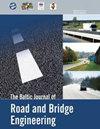水平弯道半径对两车道农村公路行驶速度影响的评价试点研究
IF 1.1
4区 工程技术
Q4 ENGINEERING, CIVIL
引用次数: 3
摘要
本文以区域道路水平弯道车速为例进行了研究。对区域道路水平弯道行车速度的文献综述,反映了设计车速与行驶车速之间的差异。在2610号区域公路上进行了10个水平弯道的行车速度测量。将收集到的数据与设计速度、各种设计标准以及小流量道路上的交通运行速度预测模型进行比较。在分析结果的基础上,提出了基于运行速度的水平曲线初始调节最小半径。建议的修正基于运行速度,以确保可靠的限速对道路安全的影响是合理的。实验结果表明,实测车速与允许车速和设计车速有不同的趋势。结果表明,依赖于特定曲线段的驾驶员倾向于超过规定速度限制的情况从17%到98%,从41%到100% -水平曲线上的设计速度。这项研究发现了实验研究方法的局限性。这些限制与实验场地选择与不同组合的路线元素、交通和事故数据有关。一项初步研究显示了显著的结果,并为全面研究计划提供了重要的见解。研究结果有望使其他研究人员和负责制定和实施道路设计规范技术文件的组织受益。本文章由计算机程序翻译,如有差异,请以英文原文为准。
Evaluation of Horizontal Curve Radius Effect on Driving Speed in Two Lane Rural Road. Pilot Study
This paper presents a case study of driving speed at horizontal curves in the regional road. The literature review of operating speed at horizontal curves in regional roads expresses the difference between design speed and driving speed. Driving speed was measured in ten horizontal curves on regional road No. 2610. Collected data was compared to the design speed, various design standards, and Operating Speed Prediction Models for traffic in low-volume roads. Based on result analysis, was proposed initial adjusted minimum radius of the horizontal curve based on operating speed. It is justified that proposed corrections based on operating speed ensure a credible speed limit effect on road safety. The performed experiment showed different tendencies comparing measured driving speed with permitted and design speeds. It was determined that dependent on specific curved section drivers tend to exceed posted speed limit from 17% to 98% of cases, and from 41% to 100% − the design speed in the horizontal curve. This research led to identifying the limitations of experimental research methodology. These limitations are related to experimental Site selection with different combinations of alignment elements, traffic, and accident data. A pilot study showed significant results and gave essential insights into the full-scale research plan. The results are expected to benefit both other researchers and the organisations responsible for the development and implementation of normative technical documents for road design.
求助全文
通过发布文献求助,成功后即可免费获取论文全文。
去求助
来源期刊
CiteScore
2.10
自引率
9.10%
发文量
25
审稿时长
>12 weeks
期刊介绍:
THE JOURNAL IS DESIGNED FOR PUBLISHING PAPERS CONCERNING THE FOLLOWING AREAS OF RESEARCH:
road and bridge research and design,
road construction materials and technologies,
bridge construction materials and technologies,
road and bridge repair,
road and bridge maintenance,
traffic safety,
road and bridge information technologies,
environmental issues,
road climatology,
low-volume roads,
normative documentation,
quality management and assurance,
road infrastructure and its assessment,
asset management,
road and bridge construction financing,
specialist pre-service and in-service training;

 求助内容:
求助内容: 应助结果提醒方式:
应助结果提醒方式:


